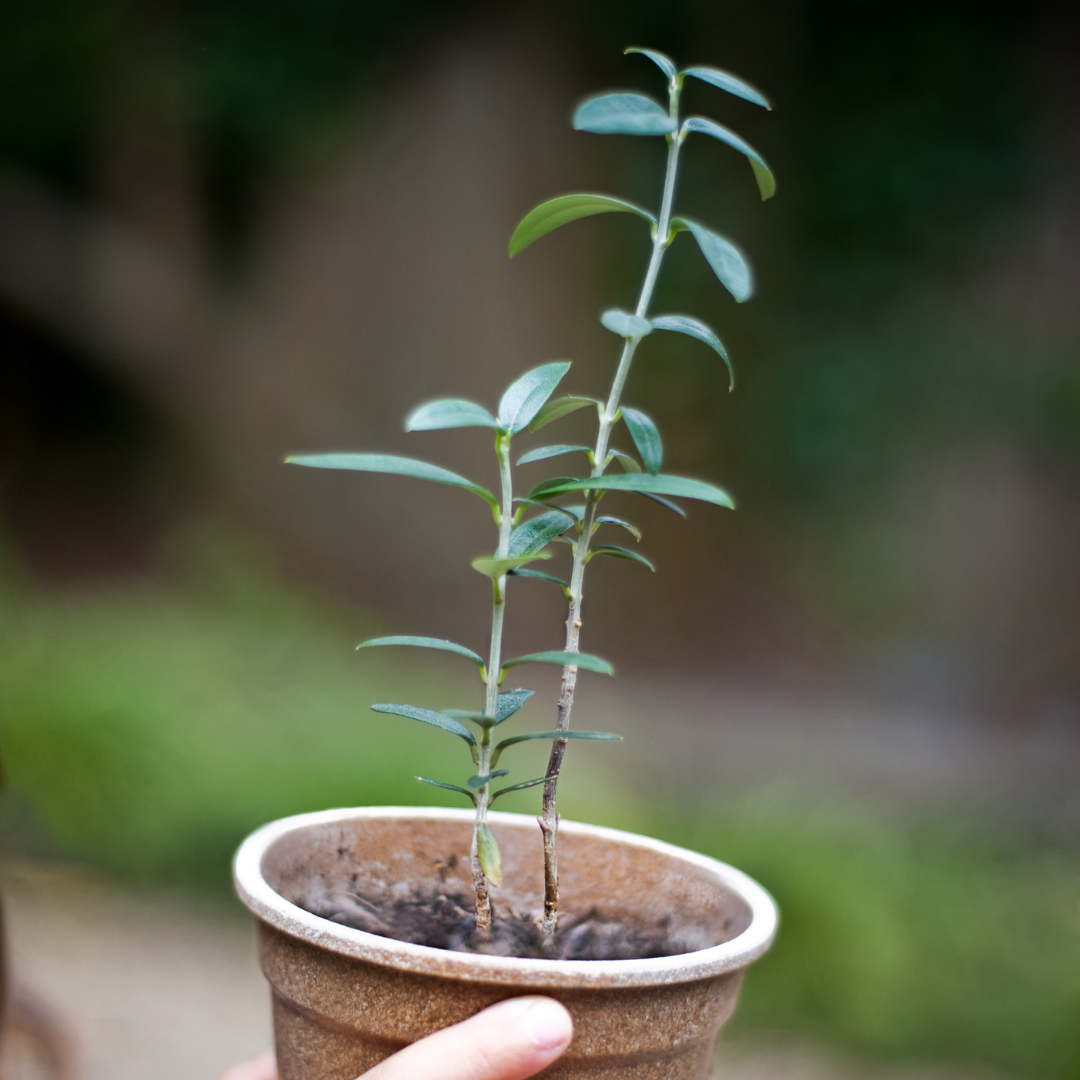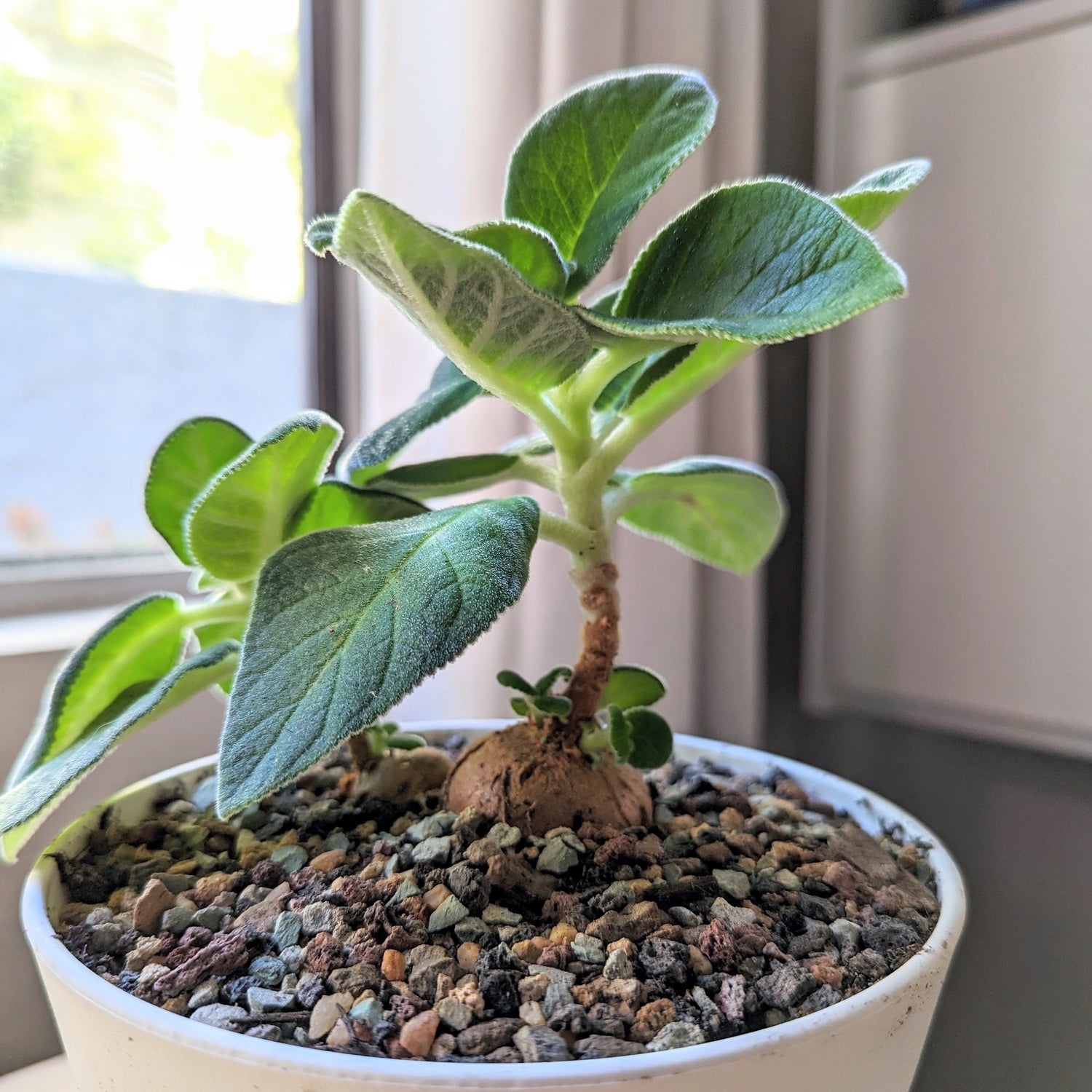Growing houseplants from seed is trickier than growing herbs or veggies. I already have 2 different blogs on how to grow houseplants from seed(How to Grow Houseplants from Seed, and Why your Seeds aren’t Germinating: Common Mistakes Made Growing Houseplants from Seed, and How to Fix Them). While those cover a lot of the conditions necessary to get the seeds to germinate, I don’t go into much detail describing different methods to help create those conditions, so here’s the post to do just that!
To start, let’s break down the components of a set-up:

-
Moisture: With a lot of the tropical varieties, the moisture is perhaps the most important thing. Each seed variety has it’s own requirements, but in general humidity needs to be at least 70% and up to get most varieties to germinate, and with some, 90% and up is recommended. Most of this post will be about setups that help give seeds the humidity they need to germinate, but one thing to keep in mind is in a lot of cases, pre-soaking is a good idea, especially varieties like Dwarf Umbrella plants, Palms and Carnivorous Plants.
-
Warmth: Usually the second most important component of a setup. 70F-90F tends to be the sweet spot to get successful germination, although it’s different for each seed variety and you should look up what the ideal temperature is for a particular plant. However the general rule of thumb is, the warmer it is, the faster the seeds will germinate. There’s a cap on that temperature of course, usually anything over 90F starts to get harmful.
The best way to achieve a good temperature is either keeping the seeds in a warm part of your house, or to be safe, keep the seeds on a heat mat that’ll help ensure that the seeds stay at the temperature you want them to.
-
Light: For many seed varieties, light isn’t necessary at all to germinate, however it’s better to have it set up and ready because the seedlings will need it to keep up their growth.
There are 2 ways to get the seeds the light they need: either you can place them by a windowsill(for houseplants, out of direct sunlight), or you can use grow lights. The perks of using a windowsill is it’s budget-friendly and just easy, however you need to keep in mind that the areas around windows can be drafty and just fluctuate in temperature a lot, so you really need to keep an eye on the temperature of the seeds. Grow lights are a good solution if you can afford them, you can set a timer to vary the amount of light the seeds get.
The best setup you can do year-round for seeds is a heat mat, mini greenhouse and grow lights- the customers I’ve had with the best success germinating seeds almost always had this setup. That being said, if you’re on a budget, you don’t have to follow this route! Hopefully you’ll get some tips from this post that’ll help you figure out what germination methods to use for your seeds, home and budget :)
1) The Class Starter Method: The Ziploc Bag Method

The ultimate budget-friendly seed starting method. It’s not always perfect, but it’s pretty dang good. It’s simple, you can use a regular 3” nursery pot, which a lot of us have lying around, plant the seeds and then cover them up with a ziploc bag- they’re about the perfect size to cover those planters!
That creates a little humidity dome for the seeds, and will help keep the seeds both humid and warm. However, you’ll want to keep them in a warm spot, if you have a heat mat, that’s ideal. Otherwise, a warmer spot in the house would work. Finally make sure that they’re in a brightly lit spot, you can use grow lights or a windowsill out of direct sunlight- just make sure the window isn’t too drafty!
I’ve personally have success germinating the seeds by an east, west and north facing window all year round at room temperature- if you don’t have a heat mat, it’ll take longer and possibly not all the seeds will germinate but it’s doable. Another note, make sure that the soil is moist when you plant the seeds. You can usually tell that the dome is working properly, as in it has enough humidity and warmth, when there’s condensation forming under the dome.
pros: budget-friendly and easy to set up!
cons: It’s just a little harder to get the ziploc on and off of the seeds, it’s important to air out the soil for small periods of time.
2) The Paper Towel Method

Fatsia Japonica sprouts germinated via the paper towel method. You should pot them up before they look like this, I just kept them here like so for fun :)
The paper towel method is a great option, and I always recommend setting aside some of your seeds to plant with this method just because it’s a great way to test for viability.
To sow the seeds, get a paper towel, wet it down with water, place the seeds spread out on the towel, then gently fold it up. Fold it into a size so that it can fit into a ziploc baggie, and make sure the seeds are covered by the towel. Keep it in the ziploc bag, and monitor to ensure that the paper towel remains moist. Once you see the seeds start to germinate you can gently remove them without damaging any roots that grew in and plant them into soil.
pros: You can track the germination of the seeds, and it tends to be easier and faster to get seeds to germinate this way.
cons: If you wait too long to move the seedlings it’ll be hard to transplant, damaging the seedling’s chances of adapting to their new environment and growing further.

3) Moss-in-a-bag Method
Very similar to the paper towel method, the idea of this is to get sphagnum moss or perlite, moisten it down, and add it into a ziploc bag. You place the seeds in the medium until they germinate. It’s great for harder-shelled seeds like palm seeds
pros: Great way to get the seeds the moisture they need, so in particular great for palm seeds or other tough seeds like coffea catura.
cons: No downsides really, you risk mold growth, which is the case for any of the other methods, but other than that it’s easy to lose the smaller seeds in the mix so it’s usually reserved for the larger and tougher seed varieties.
Tips: You’ll want to ensure that the medium is sterile, so you can consider microwaving or baking the perlite/sphagnum moss before planting the seeds. Make sure you also open up the ziploc bag every once in a while to allow for some air flow.
4) The Mini Greenhouse

Lil Maia is always curious about seed projects!
One of the more reliable solutions, it’s just a slightly better version than the ziploc bag method. What’s particularly nice about trays apart from the easily removeable lids, is they heat a little more evenly when placed on a heat mat. On top of that, the seeds are a little easier to organize since most of the time you’ll be using soil pods, making it easier to distribute the seeds, and then transplant them when they’re ready.
If you’re using mini greenhouses like these, then all you need to do is place the soil pods in the cavities, then pour warm water until it stops absorbing into the soil pods. With these greenhouses, that’s about 2 cups. From there, you can plant the seeds in the expanded soil pods, put the lids on, and then place the greenhouses either on a windowsill or wherever you have your mini nursery setup.
By far the methods I use myself most are the ziploc method and the mini greenhouse, so I can’t recommend these enough!
pros: It’s extremely reliable and easy.
cons: It’s not as budget-friendly, if you can get it, definitely do so, otherwise, go for one(or several) of the other methods!
4.5) Something in between the mini greenhouse and the ziploc bag method is using a glass dome, like the ones below. You can use a nursery pot and the lid is also easier to remove than a ziploc bag :)

If you don’t have a lot of space so you can’t just hide away your seed projects, you can use glass domes to basically make your seed starting projects into home decor! Some of the other methods can be kind of an eye-sore, so this is a definite perk to glass domes!
5) Water Soaking Method
A slightly unusual and not super commonly known method is germinating the seeds in water. For this, you’ll want to start out with warm-hot water in something like a small glass or jar, place the seeds in the water, and then leave them in there until they germinate. You’ll want to change the water at least on a weekly basis, and once the seeds start germinating, you’ll want to gently plant them in soil.
pros: It can be a lot quicker and more reliable than any of the other solutions, if done correctly.
cons: If not done correctly, the seeds will spoil, so make sure you’re changing out the water regularly!

That concludes the list, you’re not limited to these methods either, you can either imitate them exactly or use them as inspiration to create your own version of a setup! If you know of any other methods for seed starting, let me know :) The key is to just be able to provide the key components a seed needs, so the methods are limitless.
I use all of these myself in different ways, I already mentioned my personal favorites are the mini greenhouse and the ziploc methods, I usually have some seeds germinating with the paper towel method and then I use the moss-in-a-bag method for my palm/cycad seeds. I don’t use water germination too much, mostly because it’s a little more high maintenance and takes up
Here are some other posts you should check out while you’re here:






1 comment
Thank you for all of this useful information. The way you explain it is very easy to understand and simple.